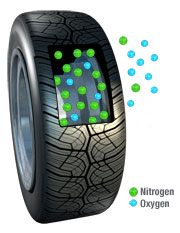 In 2007, an article in Popular Mechanics magazine bemoaning a deficiency amongst modern men and women to do common DIY tasks, found that 4 million drivers had called AAA for roadside assistance–to change a tire. With all this fear surrounding basic auto maintenance, you would think Americans would do everything in their power to avoid getting flat tires. Not so says the National Highway Traffic Safety Administration which, the same year, published “Underinflated Tires In The U.S.,” a comprehensive study that found 25 percent of cars and over 30 percent of trucks have dangerously underinflated tires. The study sites dangers beyond blowouts including reduced fuel economy, skidding, and even highway accidents and fatalities. Still, numerous follow-up studies have found American tires remain dangerously underinflated.
In 2007, an article in Popular Mechanics magazine bemoaning a deficiency amongst modern men and women to do common DIY tasks, found that 4 million drivers had called AAA for roadside assistance–to change a tire. With all this fear surrounding basic auto maintenance, you would think Americans would do everything in their power to avoid getting flat tires. Not so says the National Highway Traffic Safety Administration which, the same year, published “Underinflated Tires In The U.S.,” a comprehensive study that found 25 percent of cars and over 30 percent of trucks have dangerously underinflated tires. The study sites dangers beyond blowouts including reduced fuel economy, skidding, and even highway accidents and fatalities. Still, numerous follow-up studies have found American tires remain dangerously underinflated.
In the three years since the NHTSA study, tire pressure has come up in environmental debates, consumer reports studies and even became an issue in the 2008 presidential campaign. In that time, Pennsylvania has done its part to improve this growing problem. This week, the PA Department of Environmental Protection announced another step toward improving tire inflation with the third and final installment of the Nitrogen Tire Inflation Grants program. Tire and automotive centers looking to offer nitrogen for tire fill-up as opposed to traditional air can receive these annual match grants to acquire nitrogen tire pump technology. According to the DEP, nitrogen doesn’t escape as quickly, allowing tires to remain fuller longer and saving drivers an estimated 25 gallons of gas per year.
“Energy issues are becoming more and more important to people as our fuel is obtained from foreign sources and increasingly tied to our security,” says DEP spokesperson John Repetz. “This is something that has been out there for some time, more and more studies have been conducted and there has been a definite increase in interest from service providers who are wishing to offer this technology.”
Over the course of the Nitrogen Tire Inflation Grant program, DEP spent $300,000, bringing nitrogen tire pumps to 81 institutions state-wide. But while these grants will likely widen the usage of this more inert gas, they won’t solve the problem. According to a 2008 Consumer Reports study, nitrogen will help retain pressure longer but not to the point where motorists can forget about tire pressure all together. For true safety, the study states, you should check your tire pressure at least every few months. But for those DIY-phobic drivers out there, these nitrogen grants are a good start. Beyond reducing deflation, nitrogen has been proven to reduce wear on tire treads, making sure you won’t have to get your hands dirty for years to come.
“Nitrogen gas is less reactive with moisture at higher temperatures with the rubber of the tire so therefore you are extending the treadwear of your tire using the nitrogen,” says Repetz. “So the gas mileage is certainly one thing but there are other aspects to this that really come into play.”
Source: John Repetz, Pennsylvania Department of Environmental Protection
Writer: John Steele